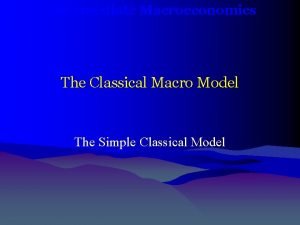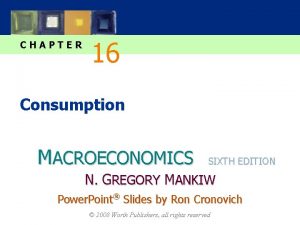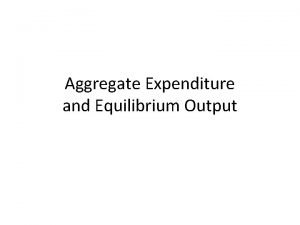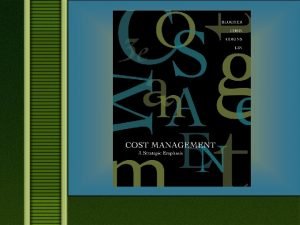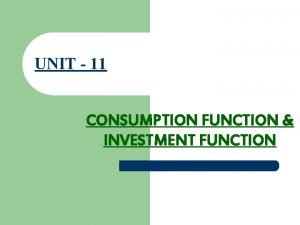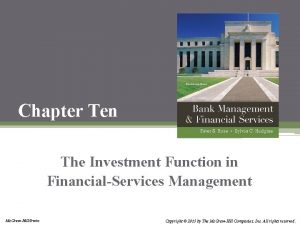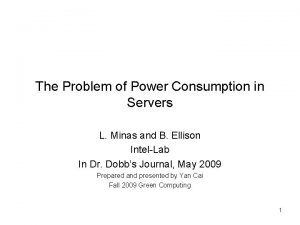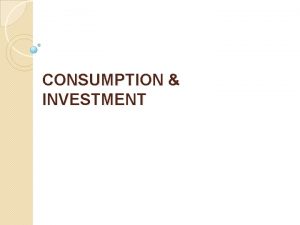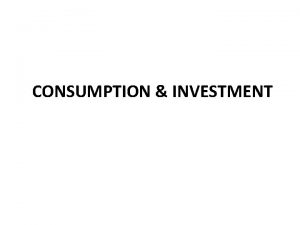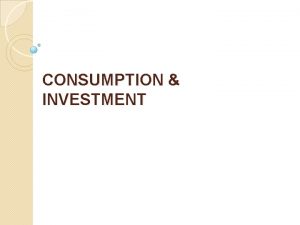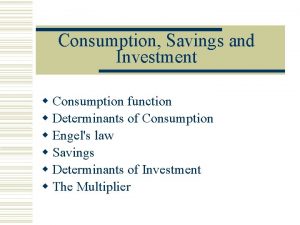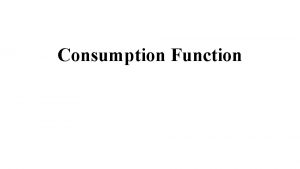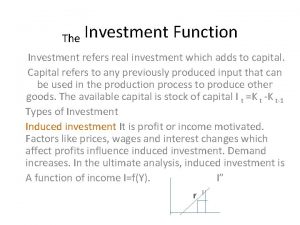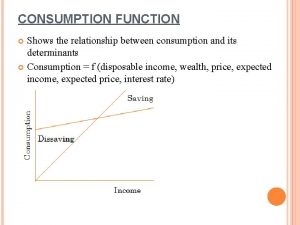UNIT 11 CONSUMPTION FUNCTION INVESTMENT FUNCTION CONSUMPTION FUNCTION















- Slides: 15

UNIT - 11 CONSUMPTION FUNCTION & INVESTMENT FUNCTION

CONSUMPTION FUNCTION ØConsumption refers to a particular amount of consumption out of a given amount of income. ØConsumption function indicates the relationship between consumption and income. ØConsumption function refers to different amounts of consumption at different level of income. C = f (Y)

PSYCHOLOGICAL LAW OF CONSUMPTION According to the law, “when aggregate income increases, consumption expenditure shall also increase but by a somewhat smaller amount. ”

THE AVERAGE PROPENSITY TO CONSUME TOTAL CONSUMPTION APC = TOTAL INCOME THE MARGINAL PROPENSITY TO CONSUME It is the incremental change in consumption as a result of a given increment in income. It is the ratio of the change in aggregate consumption to the change in the level of aggregate income.

CHARACTERISTICS OF MPC : ØValue is always positive but less than 1. ØMPC is greater than 0. ØIt goes down as income increases. ØMPC of the poor is greater than that of the rich.

RELATIONSHIP BETWEEN MPC & APC INCOME CONSUMPTION APC MPC 100 100% - 200 180 90% 80% 300 240 80% 60% 400 280 70% 40% 500 300 60% 20%

INVESTMENT FUNCTION Investment is the creation of income – earning assets. TYPES OF INVESTMENTS: ØPrivate Investment ØPublic Investment ØForeign Investment ØInduced Investment ØAutonomous Investment

SOME OTHER KINDS OF INVESTMENTS: ØGROSS INVESTMENT ØREPLACEMENT INVESTMENT ØNET INVESTMENT ØEx – ANTE INVESTMENT ØEx – POST INVESTMENT

MARGINAL EFFICIENCY OF CAPITAL ØIt may be defined as the highest rate of return over cost accruing from an additional unit of capital asset. ØProspective yield from the capital assets. ØSupply price (cost of capital assets) Q 1 Q 2 Cr = Q 3 + 1 (1+r) Qn + (1+r) 2 + ……………… + (1+r) 3 n (1+r)

DETERMINANTS OF MEC : SHORT – RUN FACTORS: ØCost & Price ØHigher propensity to consume ØCurrent rate of expectation ØChanges in income ØState of business confidence

LONG – RUN FACTORS: ØRate of growth of population ØDevelopment of new areas ØTechnological progress ØProductive capacity of existing capital equipments ØRate of current investment

MULTIPLIER It is defined as ratio of change in income to a change in investment. Multiplier is a number which gives a multiple increase in national income due a given increase in investment, i. e. I CHANGE IN INCOME K= CHANGE IN INVESTMENT 1 K= 1 - MPC

ASSUMPTIONS AND LIMITATIONS OF THE MULTIPLIER : ØAvailability of consumer goods. ØMaintenance of Investments. ØNet increase in Investments. ØNo change in the size of MPC. ØNo time gap between successive expenditure on consumption. ØExistence of closed economy. ØIt is based on number of assumptions.

LEAKAGES : ØSavings ØAccumulation of idle cash balance. ØDebt cancellations. ØPurchase of old shares and stocks. ØImports. ØTaxes. ØCorporate savings.

ACCELERATOR ∆I A = ----------∆C
 Difference between investment and consumption
Difference between investment and consumption Fixed investment and inventory investment
Fixed investment and inventory investment Keynesian consumption function
Keynesian consumption function Consumption function formula
Consumption function formula Keynesian consumption function
Keynesian consumption function Autonomous investment
Autonomous investment Unit 10, unit 10 review tests, unit 10 general test
Unit 10, unit 10 review tests, unit 10 general test What is strategic investment unit
What is strategic investment unit Pros and cons of investment banking
Pros and cons of investment banking What is investment function
What is investment function The investment function in financial services management
The investment function in financial services management World tea consumption
World tea consumption Server power consumption
Server power consumption Functional tea market share
Functional tea market share School water audit
School water audit Lack of carbohydrates
Lack of carbohydrates


